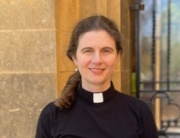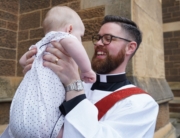A Sermon by The Rev’d Canon Jenny Wilson
John 16:16-24
In the name of God, creating, redeeming, sanctifying, … Amen.
I wonder if it was like a Clarice Beckett painting, the Ascension, I mean. I wonder if it was like one of Clarice Beckett’s paintings in the exhibition entitled The present moment showing in our Art Gallery. A friend told me about the paintings, after she saw them at the gallery, and so I wanted to see for myself. My friend said that you couldn’t see the boundaries between things, the paintings were so misty it was difficult to see where one thing ended and the next began. So I wondered if the paintings might be a little like the Ascension, the day when Jesus, the resurrected Jesus, left the earth and went to be with his God.
‘A little while, and you will no longer see me, and again a little while, and you will see me.’ [Jesus says, when he is talking to the disciples as the walk towards the garden after their final supper together.] The disciples wonder, ‘What does he mean by saying to us, “A little while, and you will no longer see me, and again a little while, and you will see me”’ , ‘What does he mean by this “a little while”? We do not know what he is talking about.’ Jesus knows that they want to ask him, so he says to them, ‘Are you discussing among yourselves what I meant when I said, “A little while, and you will no longer see me, and again a little while, and you will see me”? Very truly, I tell you, you will weep and mourn, but the world will rejoice; you will have pain, but your pain will turn into joy.’
It was after the resurrection appearances that he left them for good. He came to them in such different ways, just as they needed him, really, in the resurrection. He said Mary’s name by the tomb and he brought peace to the disciples frightened in the upper room. He showed Thomas his hands and his side, and, Peter, he forgave Peter by the charcoal fire. He came to them just as they needed him. Then it was after these appearances that he was taken up to heaven. It was after the appearances that he led the disciples as far as Bethany and, lifting up his hands, he blessed them and while he was blessing them he was carried up into heaven, so Luke’s Gospel says.
‘A little while, and you will no longer see me, and again a little while, and you will see me.’ Jesus said in our reading from John’s Gospel tonight. And this was true. They lost him as he died and then they saw him again in the resurrection. They did weep and mourn and then their pain did turn into joy, a mysterious joy, admittedly. And then, he went again, carried up into heaven as he blessed them. And this time, they did not seem engulfed in sadness, they did not seem to weep and mourn. This time they seemed almost at home with his departure.
I went to the Art gallery and I looked at the Clarice Beckett paintings. My favourite ones were of sunsets by the sea. It’s like that in an exhibition, don’t you think? There are so many paintings and so you find one or two that seem to reach out to you and then you sit with those one or two paintings. So, for me, it was the sunsets by the sea. In one of the paintings there was a figure, a person. The painting was so misty that you couldn’t tell much about them but they were walking away from you. Walking on the sand. And the sand blurred into the sea. And then the sea blurred into the sky. And in the sky was a beautiful gentle soft orange sun. All the colours in the Clarice Beckett paintings were soft. It was as if the figure was walking, guided by the gentle orange light of the setting sun. And I did wonder if the Ascension might be just like this painting. With Jesus seeing God, the gentle orange sun, and knowing his time had come to leave the earth, and leave his human life, fixed in a time and a place, and be with God. And if watching it for the disciples hadn’t been as mysterious as this painting. Where the boundaries weren’t clear at all. As if really the boundaries didn’t matter. As if the separation between sand and sea and sky didn’t matter. And, as Jesus was ascending to his father, what might have seemed like an awful wrench wasn’t at all. Because the boundaries weren’t clear, perhaps?
In Celtic spirituality, the writers speak about “thin places”, where the boundaries between earth and heaven aren’t clear. Margaret Silf, who writes about Celtic spirituality, put it this way:
“For the Celts there was never any shadow of doubt that these two worlds, the visible and the invisible, the material and the spiritual, were one. In every way the visible and the invisible were interwoven, as surely as the air we breathe and the food we eat come together to give life to our bodies. The invisible was separated from our sense perceptions only by the permeable membrane of consciousness. Sometimes that membrane could seem as solid as a brick wall. Sometimes it could be very thin. Indeed we speak even today of some places being as ‘thin places’, meaning that the presence of the invisible and the spiritual in those places is almost palpable.”[1]
The ascension of Jesus was a thin place. And the disciples sensed this, reassured perhaps by his closeness to them in the resurrection. Jesus came and went in his earthly life with the disciples, came and went when he ministered to them and then disappeared up his mountain to pray alone, came and went when he died on the cross, came and went when he appeared resurrected and then ascended into heaven. It was the way of him. But by the time the ascension of Jesus happened it was almost as if the disciples knew, knew in the thinness of that place, knew that the boundary between earth and heaven was like a whisper and they needn’t be troubled by his disappearances any more. Yes. The ascension of Jesus was a thin place. Perhaps the ascension of Jesus is the thin place.
We might have our own thin places. Places in nature where we know we can just sit, and without our needing to struggle to pray, God sometimes seems close. For me the nearest place is Encounter Bay. Just sitting, watching the gentle waves roll in, and the birds fossick and fly, and the smell of seaweed and just once in a while a sea urchin, those round shells in red or green or purple of white, almost seems to call out to me from the midst of that seaweed. And all I need to do is sit and watch the gentle waves. And every now and then the boundaries between earth and heaven don’t seem clear at all. Every now and then one might almost say that God is close.
Was the Ascension like that I wonder? Like the places where God is closest to us? Like a Clarice Beckett painting that is so misty that you couldn’t tell much about the figure in it but they were walking away from you. Walking on the sand. And the sand blurs into the sea. And then the sea blurs into the sky. And in the sky is a beautiful gentle soft orange sun. And it is as if the figure is walking guided by the gentle orange light of the setting sun.
The disciples weren’t troubled when he left them this time, when he ascended to be with God…. And when we are fortunate to find peace in our thin places, perhaps, we might notice that we are not troubled either.
[1] Margaret Silf, Sacred Spaces: Stations on a Celtic Way, p9.





